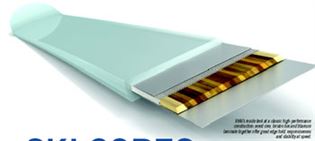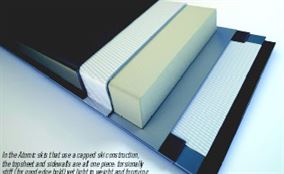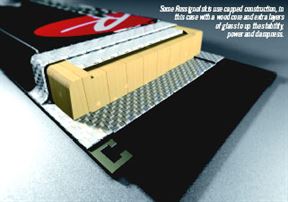SKI CORES:
heart of the matter
by Ian March from Buyer’s Guide 2010 issue
With skis, just as in love, we are often initially drawn to our mate by what’s on the
surface. But, as your parents should have told you, for true happiness, it’s what’s
inside that counts.
To avoid a broken heart, let’s go beneath the surface, right to the core. The personality and feel of a ski is the result of a combination of construction materials, construction methods and dimensions. If two or more manufacturers made skis with the exact same dimensions, they can still feel very different on snow, but for this discussion let’s take dimensions out of the equation. So what makes the difference? Likely the largest contributor to the ski’s feel is the core, mostly what it’s made of and also how it’s put together. The core influences such important factors as a ski’s weight, dampness (ability to absorb vibration), stability, responsiveness and energy. The following are some generalizations to keep in mind on ski cores, their construction and characteristics.
CORE MATERIALS
WOOD: Heavier, stable, damp, responsive,
durable and solid-feeling with consistent flex.
INJECTED FOAM: Light, quick-feeling, less
stable than other cores, but also less expensive
to produce.
FOAM (milled or cut from a block): Light,
energetic feel; generally less damp and less
stable than wood; more consistent flex than
injected foam; and generally between injected
foam and wood in terms of cost.
LAMINATE: Layers of materials bonded together
using epoxy, heat and pressure. Various types
of wood or foam can be laminated to create
a ski’s core, e.g. using a centre of birch (for
strength) with balsa bonded to it will produce a
lightweight core that absorbs vibration well.
CONSTRUCTION
But wait! Again, just as in love, it’s not that
simple. Let’s not forget construction. The
construction surrounding the core works with
the core’s characteristics to ultimately finetune
the feel and capability of the ski. There
are three main construction techniques in
today’s skis, each offering its own unique
benefits and tradeoffs.

Völkl’s inside look at a classic high-performance
construction: wood core, torsion box and titanium
laminate together offer great edge hold, responsiveness
and stability at speed.
TORSION BOX: Fibreglass layers wrapped
around the core add torsional stiffness
to a ski, resulting in excellent edge hold,
consistent flex and durability. Torsion-box
construction generally results in a more
demanding ski to use. Stronger skiers take
note, a large number of race skis at the World
Cup level, as well as many higher-end freeride
skis, use torsion-box construction.
SANDWICH: Various laminates (metal,
titanium, fibreglass) layer along the top
or bottom of the core to alter flex and
dampness. For example, adding a layer of
metal can add weight (yes, this can be a good
thing), stability and vibration absorption
(dampness).

In the Atomic skis that use a capped ski construction,
the topsheet and sidewalls are all one piece: torsionally
stiff (for good edge hold) yet light in weight and forgiving.
CAPPED: In the case of capped or monocoque construction, the topsheet and sidewalls are formed as one piece, like a cap that surrounds the ski. The cap bears the load of the ski. While the cap adds to torsional stiffness, at the same time it allows the ski to be light in weight and softer overall (longitudinally), resulting in a more forgiving ski that still has good edge hold—a very good thing for aspiring skiers who spend a lot of time on eastern hardpack.
CHARACTERISTICS
So what does all of this mean? What about
me and my search for the perfect mate? Easy
there, Romeo, use your head here. Keep these
core and construction characteristics in mind
when thinking about what you’re looking for
(in a ski!) and what “feel” you like:
• Do you like a light, quick ski? Are you
less concerned about stability at speed? A
foam core might generally keep the quick
and nimble happy.• Do you like to blast through everything,
moguls and crud exploding beneath your
feet? Maybe the solid feel and durability
of wood is up your alley.• Do you need or simply like a forgiving
ski, but get nervous on hard snow and
ice? Capped construction can offer both
forgiveness and good edge hold.• Do you aspire to race on the World Cup
or at least beat your friends in the gates?
The awesome edge hold of a torsion box,
the dampening of a wood core and a
metal layer just might be your ticket to
the podium.
If you still have cold feet and are
not sure, other questions you could ask
yourself are: What factors took a ski
experience from the competent to the
sublime, and what in the ski helped make
it so? Was it the ski’s solid feeling that
gave you con?dence and enabled you to
push yourself to new limits? The quick,
snappy, light feeling that made you dance
through that mogul ?eld? Or was it the
splashy graphics that look so…wait! If
this is you, then please return to the
beginning and start reading again.

Some Rossignol skis use capped construction, in
this case with a wood core and extra layers
of glass to up the stability,
power
One caveat: Remember that the
characteristics we have been discussing
are generalizations. There is no substitute
for actually trying a ski on snow. And when
you do get the opportunity to demo some
skis, ask the rep what’s inside and then see
if you can feel the characteristics while
ripping up the mountain. You’ll likely use
your demo time more effectively now that
you’re an expert on core construction. And
don’t forget the old adage when searching
for the perfect mate for the slopes: beauty
is in the eye of the beholder.



